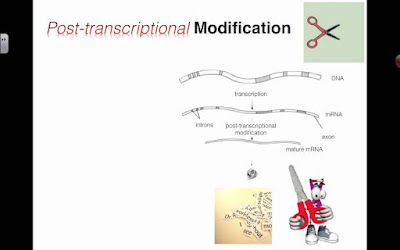Post-Transcriptional Modification
Post-Transcriptional Modification
We're looking at something specific that happens only in eukaryotic cells and it's the idea that the mRNA after it's been trench transcribed can actually be modified and you can cut out little
bits and pieces that are not necessary for the coding for the protein and then stick all the useful pieces back together hopefully you can see that in this little diagram here we're going to remove all the grey bits glue all the white bits back together and that's going to be our message that's going to be useful for translating into the final protein so let's talk about what's going on here so we have our DNA that gets transcribed here's our actual copy the mRNA we have these gray parts to remove I like to call them intruders because you're getting in the way these introns are removed and these exons are actually the good stuff.
We cut out all the gray things and then glue all the introns together it's called modification post transcriptionally so we transcribed and then we modify after transcription therefore post-transcriptional modification and we get our mature mRNA which is going to be used and delivered to the ribosomes to actually turn into the actual protein so you might be asking yourself what in the world is the point of that why not just have the original code and everything be right why have the stuff that we have to remove in order to make the final thing there's a couple different answers that come up one is that mutations can happen a lot and sometimes we can be exposed to things that can increase the chance of mutations this is one way to kind of protect the gene in a sense so for example if a mutation happens in this gray area no big deal because it's not actually being used to code for anything but if the mutation happens here I guess that's bad but by having these little bits and pieces in between that can increase the chance that you're actually preserving the code sequence so it's like built-in mmm redundancy I don't know if it's example redundancy it built in layers of protection to really keep the gene code safe that's one way to think about it and another thing that actually happens is that these exons can come together these pea is that useful pieces can actually come together in different ways so the simplest explanation is that all these introns disappear and then we glue everything back together into the correct order but in actuality in certain types of genes this modification can happen and then for example piece 1 and piece for and piece 5 can come together to produce one or piece one four five six seven and eight can come together to form something and when they actually get translated you can end up producing different proteins so in one gene in one section of DNA you can actually produce more than one protein.
So that's kind of cool as well too so that can actually go on so let's see what else we have
added here we can take a look at I mentioned only happens in eukaryotic cells in the nucleus this happens in the nucleus before the mRNA actually goes out the coding sequences called exons are interrupted by non-coding sequences or intruders called introns the introns already moved the another very cool word slice splice means to separate things into pieces but splice means to take the slice and paste it back together I just made that up splice means to be able to stick things back together I don't know rhymes with slice can be kind of confusing but add the P in there for the pasty glue those pieces are glued together to form the mature mRNA and I just mentioned many of these exons can be spliced together in different ways to produce different proteins it actually increases the total number of proteins that an organism can produce if one gene can produce five different proteins by splicing the exons together in different ways now you've just multiplied the number of possible genes if on average each gene can be mixed up five different ways you just increase the number of possible proteins to be made by five times .





Comments
Post a Comment